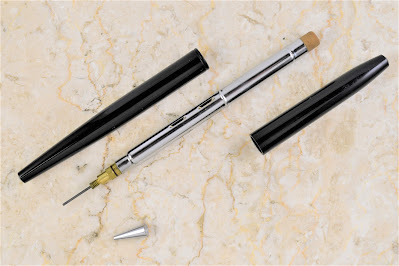This article has been included in The Leadhead's Pencil Blog Volume 7, now available here.
If you don't want the book but you enjoy the article, please consider supporting the Blog project here.
Most of the time, later Parker pencils don’t grab my attention . . . other than minor stylistic flourishes and barrels in different injection-molded colors, they’re all the same thing. It’s like Derek Zoolander’s calendar, if you’ve seen the movie.
This one, however, is different . . . the “blue steel” of later Parkers. The company's desk pencils can be particularly thorny to identify, since they lack clips, caps and other “tells” that might point definitively towards any particular Parker model line:
The imprint on this one reads simply “Parker,” with “Made in USA” on the opposite side– there’s no date code, and neither is there any “halo” logo (the oval with an arrow running through it), which Loyal Knight Mike Kirk indicates was introduced in early 1958. There’s a groove on the upper barrel - I don’t believe it was ever fitted with a metal band:
At the top end, the taper ends in a slight cone:
The tip unscrews to reveal what appears to be a Cross-built mechanism, typical for Parker, but with a little rib in the center:
The tip and mechanism are identical to some of the Parker 21 pencils in my collection:
Does that mean this is a Parker 21 desk pencil? That would be too easy. Parker didn’t care too much what went inside of the company’s pencils, as long as they were wrapped in chunks of plastic and metal that looked like their fountain pens (and in later years, their ballpoints). Replacement mechanisms were pictured in a 1960 Parker parts catalog residing in the Pen Collectors of America’s reference library, and this mechanism was listed . . . not exclusively for the Parker 21, but also on the 51 as well as the V.I.P.:
However, the mechanism illustrated as a universal donor for all these models is not an exact fit for all these models. The hexagonal section which engages a recess inside the barrel is significantly longer as pictured; I’ve got parts bins full of different variations with slightly different sizes, and I assure you that one size most certainly did not fit all. I’m fond of saying that if you have two later Parkers, they probably have three different mechanisms inside them.
I asked the peanut gallery for help with the identification, and Loyal Knights Mike Kirk and Harry Shubin came to my aid. Harry suggested it might be either a Parker Jotter or Parker 45 desk pencil; it has the girth of a Jotter, but Jotter desk tapers were more pointed than this. Mike Kirk noted that the taper matches the profile of some Parker 45 desk ballpoints, but also indicated the barrels on Parker 45s were fatter. He reports that his ballpoint is “buried I-don't-know-where,” but he found where Rob Bader has one listed in an online auction:
Note that Rob’s pen has a gold ring, but note that it steps down towards the writing end; that’s the same clutch ring carried over from the Parker 45 fountain pen line.
According to Tony Fischier’s site, Parkerpens.net, the Parker 45 was introduced in 1957 and was based on the Eversharp 10,000 (Parker acquired Eversharp’s writing instrument division that year). That might square with an early production Parker 45. National newspaper advertising for the Parker 45 was heavy in 1960, and after looking at a couple hundred of them, I gave up trying to find one that illustrated a desk pen. There are other problems with a Parker 45 diagnosis: Parker’s catalogs in the PCA library don’t show this variation, either those Parker replacement parts catalogs omit any reference to this model, and . . . unless it was made in 1957, it should have a halo logo.
Then Mike Kirk found another lead - an identical desk pencil at Parker51.com, in the desk pens section (http://parker51.com/index.php/51s/desks/). The author identifies it as a Parker 51 desk pencil and further states that it has a 1953 date code.
Identification as a Parker 51 desk pencil would fit; if that’s what it is (and if Parker was consistent, an enormous “IF”), we can pinpoint exactly when it was made. Mike Kirk reports that his latest date-coded Parker is marked 1955; if Parker discontinued date codes after that year, this suggests production in 1956 or later.
As mentioned earlier, the absence of a Parker halo logo suggests pre-1958 production, but we can narrow things down even more. The 1957 Parker catalog in the PCA’s library illustrates desk pens, and even with the terrible quality of the copy, tapers on these pens clearly show bright metal tips:
There’s our contingent answer: IF this is a Parker 51 desk pencil, and IF Parker discontinued date codes after 1955, and IF Parker universally abandoned the stubbier desk tapers by 1957, this is a Parker 51 desk pencil from 1956.
Oh, and there’s one other thing . . . IF Parker universally used chrome plated tips on the Parker 51 “Special” line, it’s a 1956 Parker 51 Special desk pencil.
If, of course, someone over the last 60 years didn’t simply replace the tip . . .









The desk pens with metal tip are ~57 as shown in your catalog illustration. Parker stopped dating pencils during 1956, so yours is 56-57. It’s basically a 51 Special with a taper. The pencil is skinnier than the pen and had it’s own dedicated socket. Ernesto Soler shows the pencil here:
ReplyDeletehttp://parker51.com/?s=Deskbases